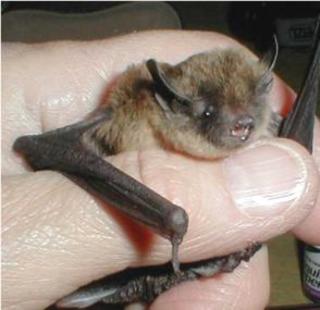
Long-legged myotis
Order : Chiroptera
Family : Vespertilionidae
Subfamily : Vespertilioninae
Species : Myotis volans
The Long-legged myotis is listed as Least Concern (LR/lc), lowest risk. Does not qualify for a more at risk category. Widespread and abundant taxa are included in this category, on the IUCN Red List of Threatened Species
Some facts about the
Long-legged myotis
Adult weight : 0.007 kg (0.0154 lbs)
Maximum longevity : 21 years
Female maturity :152 days
Litter size : 1
Interval between litters : 365 days
Facts about the long-legged myotis
1996: Myotis volans is uncommon within the White Sands Missile Range.
Although the long-legged myotis is uncommon in Wind Cave National Park, it is one of western America's most widely distributed bat species.
IDENTIFYING CHARACTERISTICS AND LIFE HISTORY: Myotis volans is recognized by its short rounded ears, small hindfeet, long tibia, distinctly keeled calcar, and long, dense fur on the underside of the wing membrane that extends from the body to a line joining the elbow and the knees.
Range MYOTIS VOLANS is very common and widespread in parts of it's range.
The long-legged myotis (Myotis volans) is one of western North America's most widely distributed bats.
The long-legged myotis is one of western America's most widely distributed bat species.
The long-legged myotis is the only medium-sized myotis with short, rounded ears (10-15mm), small feet, distinctly keeled calcar, and fur on the underside of the wing membrane extending from the body to the elbow and knee.
The long-legged myotis, Myotis volans, is a small bat that occurs in the western United States, as well as in western Canada and Mexico. (Full text)
Fish and Wildlife Service as Threatened or Endangered Life History The long-legged myotis is described as having cinnamon red to dark brown fur above (Full text)
Myotis volans is found from North Dakota, south through Texas and west to the pacific coast of the United States, central Mexico, Baja California, and central to north western Canada. (Full text)
The long-legged myotis is a forest bat species of Western North America. (Full text)
Habitat: The long-legged myotis is primarily a coniferous forest bat but occasionally is found in evergreen-deciduous forests, and it evidently tolerates the essentially treeless, barren badlands of northwestern Nebraska and the western Dakotas. (Full text)
Long-legged Myotis ClassOrderFamilySpecies Mammalia Chiroptera Vespertilionidae Myotis volans Long-legged Myotis Distribution, Abundance, and Seasonality The long-legged myotis is common in California, occurring in the coastal ranges from Oregon to Mexico, the Cascade/Sierra Nevada ranges to southern California, most of the Great Basin region, and in several Mojave Desert mountain ranges. (Full text)
Identification: Myotis volans is recognized by its short rounded ears, small hind feet, (Full text)
Population Trends and Protection Status: The long-legged myotis is a former category 2 candidate species. (Full text)
More animals beginning with L
